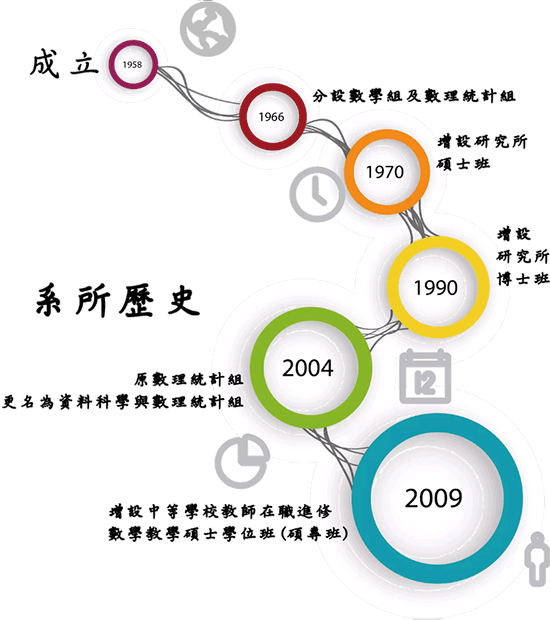Introduction
Development History:
The department was established in July 1958. In July 1966, it was divided into two groups: the Mathematics Group and the Mathematical Statistics Group (the Mathematical Statistics Group was renamed the Data Science and Mathematical Statistics Group in August 2004). In August 1970, the Master’s Program was added, and the Ph.D. program was established in 1990. In August 2009, the Master’s Program for In-Service Teachers in Secondary School Mathematics Education (In-Service Master’s Program) was introduced. In August 2016, the original Master’s Program in the Department of Mathematics was renamed to the Master’s Program in Mathematics and Data Science. The In-Service Master’s Program was also transformed into the In-Service Master’s Program in Mathematics. However, due to changes in educational policies and market demand, the In-Service Master’s Program ceased admissions in the 2022 academic year.
With the growing application of data science across various fields, the department aimed to highlight the significance of data science and emphasize its role in applied mathematics. This change was intended to attract more students interested in applied mathematics and data science. Hence, in August 2024, the Department of Mathematics was renamed the Department of Applied Mathematics and Data Science to reflect the department’s expanding academic scope and development trends. Currently, there are 403 undergraduate students, 15 graduate students in the Master’s Program, 11 in the In-Service Master’s Program, and 8 Ph.D. students. Over its 60-year history, the department has graduated approximately 5,425 students, who have excelled in both domestic and international educational institutions and industries.

Emblem Design Concept:

The design of the department’s emblem is inspired by Euler’s formula, often hailed as “God’s formula” or “the greatest mathematical formula,” due to its irreplaceable significance in advanced mathematics and physics. The formula unites five seemingly unrelated mathematical symbols—e (Euler number), i (the imaginary unit), π (Pi), 1 (the multiplicative identity), and 0 (zero)—to showcase the beauty and infinite possibilities of mathematics. These five symbols encircle the number 1958, representing the founding year of the department. The emblem symbolizes the department’s long-standing history and tradition, with hopes for continuous development and exploration in the fields of mathematics and data science, embracing future challenges.
Features:
Currently, the department consists of 9 professors, 5 associate professors, and 5 assistant professors, all holding Ph.D. degrees, making a total of 19 faculty members. The department has a complete teaching faculty, with strengths in various fields of mathematics. The faculty is dedicated to teaching and has a strong research atmosphere, with an average of 16 projects funded by the National Science Council each year over the past three years, and an average of 40 journal papers and one book published annually.
The department also employs several full-time teaching assistants responsible for the tutorials of required courses, ensuring the effectiveness of student learning. Additionally, the department has been publishing the Tamkang Journal of Mathematics for over 50 years. This international journal is exchanged with over 100 mathematics journals worldwide, and its editorial board includes renowned scholars from the U.S., Canada, and China. Manuscripts are submitted from countries around the world.
The mission of the undergraduate and graduate programs is to cultivate talent in mathematics, statistics, and related scientific applications and research. The department offers basic mathematics courses and general mathematics education to students across the university, helping them develop skills in thinking, organizing, analyzing, and expressing themselves through the study of mathematics. The department provides professional training in mathematical theory, applied mathematics, statistical analysis, and data science practices.
The In-Service Master’s Program aims to provide advanced training for mathematics educators and to cultivate talent in statistical analysis and data science practices. The program offers new knowledge in mathematics education, enhances skills in computer-based multimedia teaching, and provides training in statistical analysis and data science practices. The department’s teaching and research emphasize both theory and application. A dedicated computer lab is equipped with mathematical and statistical software to enhance students’ understanding of theoretical concepts through numerical calculations and visual representations, and to strengthen their practical skills through applied analysis courses.
Key planning highlights include:
Mathematical Theory and Applications:
Courses cover topics such as algebra, analysis, algebraic topology, computational mathematics, geometry, complex function theory, differential equations, combinatorics, databases, and deep learning. These areas not only form the foundation of mathematics but also play crucial roles in various industries. In addition, students are trained in artificial intelligence knowledge and skills to meet the rapidly evolving demands of modern technology.
Data Analysis Theory and Applications:
Courses cover probability theory, statistics, mathematical statistics, data science algorithms, biostatistics, industrial statistics, and statistical computing. These fields play significant roles in the development of research in medicine, pharmaceuticals, industrial production, and the social sciences. As a result, we place particular emphasis on statistical courses to train students in data collection and analysis.
The practical approach involves providing students with computer software and hardware resources, maintaining close collaboration with research groups in Taiwan, and expanding practical learning environments. The department maintains long-term partnerships with various research institutions (such as Academia Sinica), financial institutions (such as Fubon Financial Holding), and teaching hospitals (such as Veterans General Hospital and the National Defense Medical Center) to cultivate talent with a balance of theoretical and practical skills.
